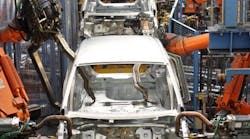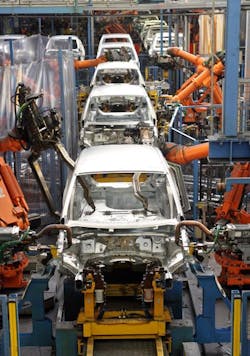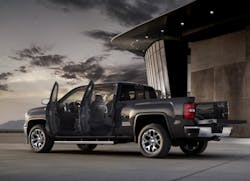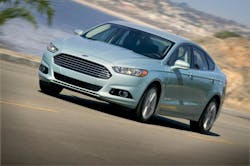That’s the conclusion of vehicle market research firm Polk, which is projecting that new light vehicle registrations in the U.S. in 2013 are expected to rise 6.6% over 2012 levels to 15.3 million units – with sales in the compact, subcompact and pickup segments leading the charge.
On top of that, North American production volumes to increase to around 15.9 million units – an anticipated 2.4% increase from 2012, according to Polk – driven by an improving economy and capacity expansion in the region.
I covered some of this in a new story yesterday, but it seems appropriate to dive into this veritable explosion of demand a little more. Not only does this translate into more freight for the trucking sector, it also means a lot of light duty fleets are starting to finally replace aging equipment – and they are getting far more capable and especially more fuel efficient products in return.
According to Polk's analysis, new vehicle introductions in 2013 will escalate dramatically, with 43 new vehicle introductions in the U.S. planned for the year – up nearly 50% over 2012 levels – with an additional 60 vehicle redesigns expected in for 2013 as well.
[One good example is the recent improvements to Ram Truck’s heavy-duty pickups and chassis cab trucks, which you can read about by clicking here.]"We expect continued recovery in the industry in 2013 and 2014, a positive sign for the U.S. economy," noted Anthony Pratt (at right), Polk’s director of forecasting for the Americas. “The auto sector is likely to continue to be one of the key sectors that lead the U.S. economic recovery; however, we don't expect to realize pre-recession levels in the 17 million vehicles range for many years.”
Indeed, the firm expects a return to 16 million units in the U.S. by 2015, if not before, barring any unusual activity in the marketplace – adding that the U.S. market last reach 16 million unit mark back in 2007, just before the Great Recession hit.
Of interest to the work truck denizens is Polk’s take on the large pickup truck segment, which, after declining over the past five years, is now likely grow with several important new launches in 2013 and into the 2014 model year, with General Motors, Toyota and Ford Motor Co. planning to showcase redesigned vehicles in this segment during the next 18 to 24 months.
GM of course rolled out brand-new 2014 versions for its venerable Chevrolet Silverado and GMC Sierra light pickups as 2012 wound to a close – you can read about those trucks by clicking here – with James Bell, GM’s head of consumer affairs, telling me that the carry-over parts from the 2013 Silverado and Sierra models could “fit into a sandwich bag,” meaning that those vehicles are about as brand new as you can get.“We haven’t really changed the exterior look of the Silverado and Sierra all that much, but what’s on the inside has undergone in many ways a total revolution,” he explained to me.
One of those big changes Bell noted revolves around a trio of all-new EcoTec3 gasoline engines designed specifically for the needs of full-size truck customers. The new EcoTec3 4.3-liter V6, 5.3-liter V-8 and 6.2-liter V-8 feature direct injection, cylinder deactivation and continuously variable valve timing to boost power, torque and fuel efficiency across a broad range of operating conditions.
Best thing is, those engines are an “extra cost” feature, according to Jordan Lee, GM’s small block chief engineer and program manager. “You get our best and most sophisticated technology regardless of trim level,” he explained.
“We also believe these are the most technologically advanced engines ever offered in light-duty pickups, and they are 100% truck – specifically designed for the way customers use trucks in the real world,” Lee added. “They have all the power and torque needed to confidently handle the tough jobs, and they seamlessly switch to four-cylinder mode to increase efficiency during light-load driving – and we offer it in every one of our EcoTec3 engines, for every one of our customers.”Yet cars are in hot demand as well, as a bevy of new models hit the streets that offer – just like their light truck brethren – more capability coupled to better fuel efficiency.
Polk’s analysis indicates that the mid-size sedan segment will continue to lead the industry. Currently at more than 18.5% of the overall market – the industry's largest segment by at least 2% – the firm thinks sales of those models will only continue to grow in the coming year.
"Recent redesigns of nearly every vehicle in the mid-size segment are forcing more competition and continued growth," said Tom Libby, Polk’s lead analyst for North America. "The current array of options for consumers in the market for a new mid-sized vehicle makes it a great time to buy a new car."
[A good example of such “options” can be discerned on the new 2013 Ford Fusion, which you can see below.]
Polk also forecasts the industry will experience continued growth in the compact and subcompact segments, as OEMs are introducing several new models in the coming year. "This anticipated growth is largely based on increasing CAFE requirements and significant new product launch activity in the U.S., as well as increased interest by younger buyers just coming into the market," noted Libby.
While the number of available hybrid models in the U.S. will increase this year, Polk anticipates only a slight improvement in this category from its current level of approximately 2.9% of the overall market.
The firm added that the reasons for this include the continued significant price differential between hybrids and traditionally-powered vehicles as well as the high number of traditionally-powered vehicles that achieve similar mileage targets as those in the hybrid segment.
Still, when you put it all together, it makes for a very positive wave of trends for the light vehicle market – and we’ll take all the good tidings we can get.







